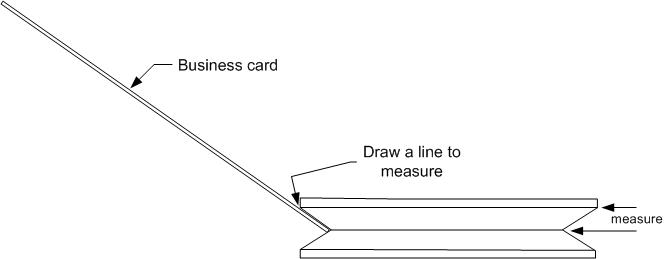|

|
Measure your BELTS
Our Mission:
To offer
quality custom components for the repair/restoration of antique and
vintage electronic devices!
Site
Created 08/10/96 Page Updated 03/30/11
Bookmark This PAGE!
NOW available pioneer
CT-93, Nakamichi BX-300 Belt KIT, and the RT-707 LED lighting
KIT
Vintage Belt
KITS Capacitors! Dial Lamps |
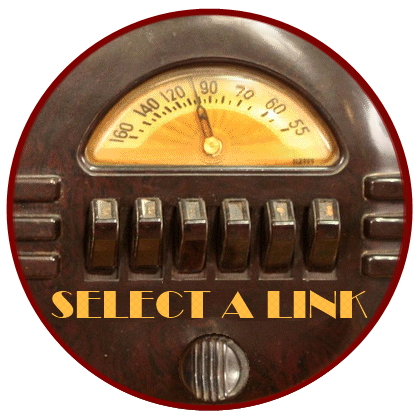
| |
Welcome to the Belt
measurement Class 101!
SQUARE BELTS - FLAT BELTS - IDLER
TIRES -
Broken/missing BELTS
I get many emails asking for certain belts
for specific decks. I dont have a backwards compatibility list. No one does! It
seems like there are thousands of way to measure these belts too. Between
measurements and deck types we have millions of possibilities.
SO! I decided to write a self help web page. This way if
you need a belt you can send the dimensions to me. Takes all the guess work out,
and helps insure that you get the correct belt. Please see the price list below.
You will have to make your own measurements then email me with your needs. I
will in turn send you an invoice, or a Paypal payment request. Its up to you.
SQUARE BELTS! (same
dimension on all four sides)
1) Refer to the ruler below to acquire the first dimension: Use
two pencils to hold the belt across the ruler but, DO NOT STRETCH the belt as
you measure it! This is very important.
2) Measure and record the belts length. In this example the belt
measures 6 inches.

3) Calculate the belts Inside
Diameter. Measured results (6") = (6" X 2) = 12" All we need to do is double
your measurment.
4) Then you need to subtract 10% to
compensate for stretching, and use of the old belt. 12" X 0.10 = 1.2" Now we
take 12" 1.2" = 10.8"
5) We now realize we need a 10.8" belt minimum. We could use any
belt between 10.8 and 11.5 assuming the measurement was accurate.
6) Since we have a square belt, then we need
to measure that
too.

7) If you have a caliper, then this would be
the best way to measure. Dont worry to much about measuring them though. We
can use common business cards. Each card is approximatly 0.015" thick. So you
need at least two because they don't make belts that small. I would start with
four cards though. Stack up the cards until they are at the same height as your
belt. Use a flat surface, and press down on the cards while measuring!
Then multiply the number of cards used. So if your belt is as high as three
cards, then the formula would look like this 3 x 0.015 = 0.045 So now we
have the second dimension. (10.8 X .045 square).
8) Thats all we need to determine the size
square belt you may need.
FLAT
BELTS!

10) We measure and record the belt diameter exactly the same as
step 2. In this example the belt measures 6 inches, B but we know to double
this. The actual dimension is 12".
11) Once again we make the same adjustment we did in step 4.
Take out 10%. Our new dimension for this example is 10.8"ID.
12) One major difference with a flat belt is an added dimension.
We already measured the length, now we need the thickness and the width.
13) Lets start with the thickness: Use the same bussiness cards
and the same methode we used in step 7. So now we have two dimentsions.
14) Lets get the final dimension (width): This can be measured
with a ruler. Just measure across the flat surface.
IDLER TIRES?
Use what we learnt and the instruction below.
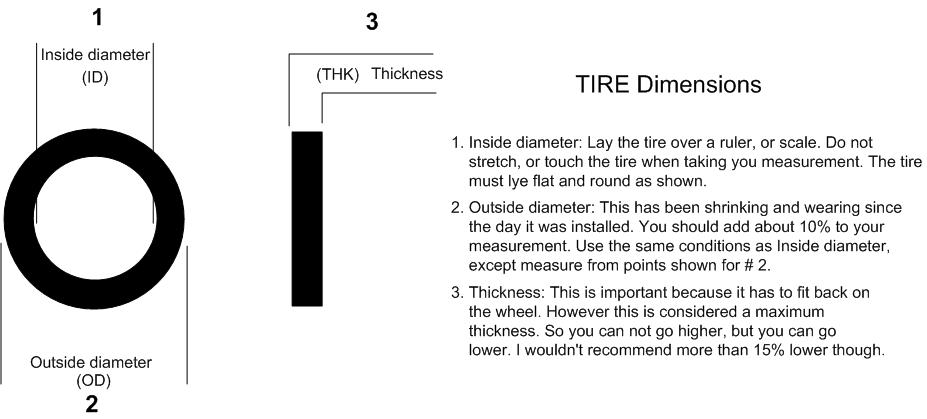
MISSING or
BROKEN?
We sometimes find the belt is
broken, missing, even melted down to a black goo. In this case we want to use
string and install it as you would the original belt. Wrap it around the pulleys
and wheels as the original would be, then tie it snug in place. The string needs
to be a stiff type that does not stretch. Dial cord would be a good example, but
cotton thread will work too. Next remove the string and
measure it as shown below.
Measure LENGTH
1) Refer to the ruler below to acquire the first dimension: Use
two pencils to hold the belt across the ruler.
2) Measure and
record the belts length. In this example the belt measures 6 inches.

3) Calculate the belts Inside
Diameter. Measured results (6") = (6" X 2) = 12" All we need to do is double
your measurment.
4) Then you need to subtract 10% to
compensate for stretching, and use of the old belt. 12" X 0.10 = 1.2" Now we
take 12" 1.2" = 10.8"
5) We now realize we need a 10.8" belt minimum. We could use any
belt between 10.8 and 11.5 assuming the measurement was accurate.
We also have a couple other measurments to be
concerned about. If this is a flat belt, then we need two other dimensions. If
there is any of the original belt left then this is easy. Just measure it. If
there in no belt then we have to measure other parts of the deck and estimate.
If we have a square belt then there is only one more dimension we need to figure
out.
Flat belts: If you have a
flat belt then it needs to run off a pulley and ride a flat surface or two. So
try these thing to figure it out, and measure the
width.
Measure
WIDTH
1) Chances are, the original belt has left
rubber markings on the flat surfaces it ran over. For example the flywheel.
Measure it and take away about 10%. The same goes for the pulley. See the figure below.
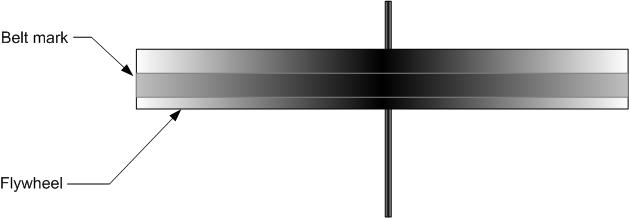
2) In my experiance the flat belt will use
about about half of the motor pulley's surface. No matter what! The belt has to
be smaller then the surface space on the pulley. See figure below.
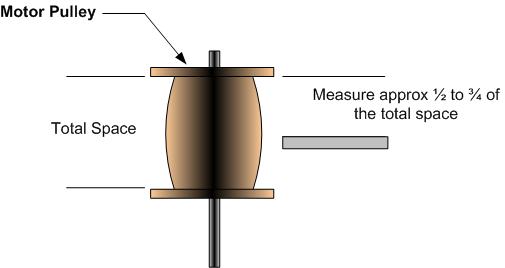
If we put the last two statements
together we have the motor pulley and the flywheel. So, to recap the belt width
must be approx one half the motor pully. It also has to be smaller than the
item(s) it turns, (flywheel) in this case. The figure below shows what this
means.

Measure
THICKNESS
If you have a peice of the belt then a caliper would be the best way to
measure. Dont worry to much about measuring them though. We can use common
business cards. Each card is approximatly 0.015" thick. So you need at least two
because they don't make belts that small. I would start with four cards though.
Stack up the cards until they are at the same height as your belt. Use a flat
surface, and press down on the cards while measuring! Then multiply the
number of cards used. So if your belt is as high as three cards,
then the formula would look like this 3 x 0.015 = 0.045 So now we have the
second dimension. (10.8 X .045
square).
If you do not have the belt then we must use experiance
here.
1) 99% of cassette decks, 8-tracks, VCRS, and other types of
smaller equipment use the standard 0.025" thick belts. This includes turn
tables.
2) If you have a good reel to reel deck, then chances are the
belt will be thicker. It could be as thick as 0.065". I would probably go with a
0.050" belt for good measure.
Measure a square belt! (same dimension on all four sides)
We sometimes find the belt is broken, missing,
even melted down to a black goo. In this case we want to use string and install
it as you would the original belt. Wrap it around the pulleys and wheels as the
original would be, then tie it snug in place, but not tight. The string needs to
be a stiff type that does not stretch. Dial cord would be a good example, but
cotton thread will work too. Next remove the string and measure it
as shown below.
Measure
LENGTH
1) Refer to the ruler below to acquire the first
dimension: Use two pencils to hold the string across the ruler.
2) Measure and
record the belts length. In this example the belt measures 6 inches.

3) Calculate the belts Inside
Diameter. Measured results (6") = (6" X 2) = 12" All we need to do is double
your measurment.
Measure
HEIGHT
This is a square belt so the height
and width should be the same. As shown in the figure below.

This may be a little tricky,
but most square belts for tape decks are between .030 and .050 inches anyway.
The best way to approximate this dimension would be to measure the depth of the
wheel the belt rides on. The figure below shows you where to measure. The hard
part is physically taking the measurment. A metal scale will work, or a caliper
with the depth gauge. You can stick a business card in the crevis and draw a
line where the top of the wheel stops. Then measure it outside the deck. Again
keep in mind most of them are between .030 and .050" so use this information as
part of your approximation.
Once you have a number, the belt dimension
needs to be smaller than your measured number. Now we want to calculate and
subtract about 15%. Then you need to find the standard dimension for
the calculated dimension. The table below shows a few examples. In the end
the belt needs to ride inside the pulley as shown.
|
|
|
|
|
|
|
|
-15% |
|
Standard |
| Measured |
|
Calculated |
|
Dimension |
TYPE |
| 0.065 |
|
0.055 |
|
.046-.050 |
SBS |
| 0.049 |
|
0.041 |
|
.030-.040 |
SBO | |

|
Quick links!
HOME Restoration
Items for SALE Price Guide Links CONTACT
US !![]()








